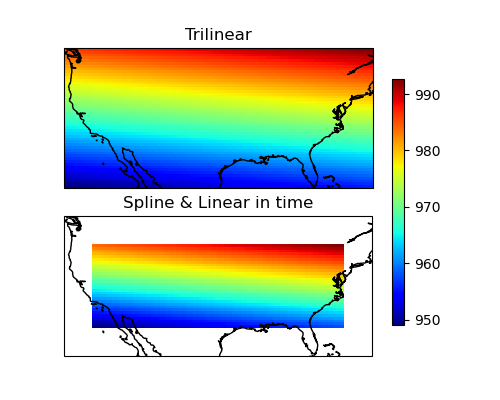Note
Go to the end to download the full example code. or to run this example in your browser via Binder
4D Interpolation#
This example demonstrates how to perform 4D interpolation on a regular grid. The pyinterp library supports both quadrivariate and bicubic interpolation for 4D data.
import cartopy.crs
import matplotlib
import matplotlib.pyplot
import numpy
import pyinterp
import pyinterp.backends.xarray
import pyinterp.tests
Quadrivariate Interpolation#
Quadrivariate interpolation extends trivariate interpolation to four dimensions. It performs bilinear interpolation on the 2D spatial plane (longitude and latitude) and then linear interpolation on the third and fourth dimensions.
First, we load the 4D dataset and create the interpolator object.
ds = pyinterp.tests.load_grid4d()
interpolator = pyinterp.backends.xarray.Grid4D(ds.pressure)
Next, we define the coordinates for interpolation.
Warning
When using a time axis, ensure that the date units are consistent
between the grid and the interpolation coordinates. The
pyinterp.TemporalAxis.safe_cast() method can help manage date
conversions and prevent inconsistencies.
mx, my, mz, mu = numpy.meshgrid(numpy.arange(-125, -70, 0.5),
numpy.arange(25, 50, 0.5),
numpy.datetime64('2000-01-01T12:00'),
0.5,
indexing='ij')
Now, we perform the quadrivariate interpolation.
quadrivariate = interpolator.quadrivariate({
'longitude': mx.ravel(),
'latitude': my.ravel(),
'time': mz.ravel(),
'level': mu.ravel()
}).reshape(mx.shape)
Bicubic Interpolation on a 4D Grid#
For smoother results, you can use bicubic interpolation for the spatial dimensions, followed by linear interpolation on the other dimensions.
Note
Bicubic interpolation requires that the grid axes are strictly increasing.
If your latitudes are in descending order, you can set the increasing_axes
parameter to True to automatically flip them.
interpolator = pyinterp.backends.xarray.Grid4D(ds.pressure,
increasing_axes=True)
We then perform the bicubic interpolation.
To visualize the results, we reshape the output arrays and extract the longitude and latitude coordinates.
quadrivariate = quadrivariate.squeeze(axis=(2, 3))
bicubic = bicubic.squeeze(axis=(2, 3))
lons = mx[:, 0].squeeze()
lats = my[0, :].squeeze()
Finally, let’s plot the results of both quadrivariate and bicubic interpolation.
Note
The resolution of the example grid is low (one pixel per degree), so the bicubic interpolation may not find enough pixels at the edges, resulting in undefined values.
fig = matplotlib.pyplot.figure(figsize=(10, 8))
fig.subplots_adjust(left=0.05, right=0.95, top=0.95, bottom=0.05, hspace=0.25)
ax1 = fig.add_subplot(
211, projection=cartopy.crs.PlateCarree(central_longitude=180))
ax1.set_extent([lons.min(), lons.max(),
lats.min(), lats.max()],
crs=cartopy.crs.PlateCarree())
pcm = ax1.pcolormesh(lons,
lats,
quadrivariate.T,
cmap='jet',
shading='auto',
transform=cartopy.crs.PlateCarree())
ax1.coastlines()
ax1.set_title('Quadrivariate Interpolation')
ax2 = fig.add_subplot(
212, projection=cartopy.crs.PlateCarree(central_longitude=180))
ax2.set_extent([lons.min(), lons.max(),
lats.min(), lats.max()],
crs=cartopy.crs.PlateCarree())
pcm = ax2.pcolormesh(lons,
lats,
bicubic.T,
cmap='jet',
shading='auto',
transform=cartopy.crs.PlateCarree())
ax2.coastlines()
ax2.set_title('Bicubic Interpolation')
fig.colorbar(pcm, ax=[ax1, ax2], shrink=0.8)

<matplotlib.colorbar.Colorbar object at 0x13a2bac00>
Total running time of the script: (0 minutes 0.536 seconds)